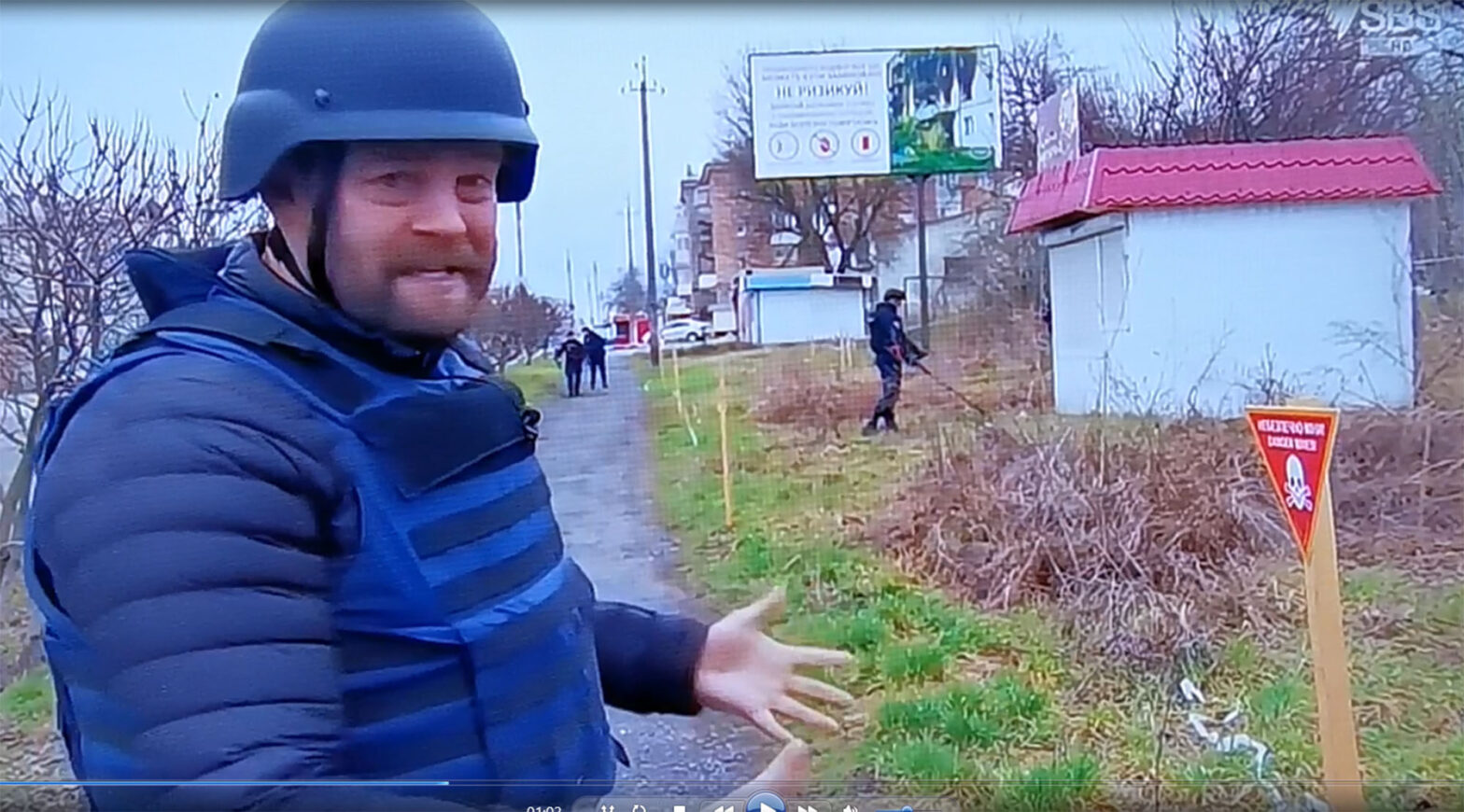Above - the BBC's James Waterhouse reports from Balakliya: "It’s hard to describe this as anything other than.. random. This is a patch of land, in the middle of Balakliya, it’s not a place - unlike other areas - that was once contested, where there was heavy fighting." "- but what these minesweepers are looking for, are so-called Butterfly mines. They’re banned by international law, they don’t look much, but the damage they can cause, is severe. They’re scattered from a flying rocket. They’re illegal because of the indiscriminate way they kill and injure civilians. In the area around Izyum, Russia and Ukraine have both been accused of using Butterfly mines; the latter denies it."
To my knowledge, no Western media has ever reported on the AFU's shelling of Donetsk and Gorlovka and other towns under Russia's control, with Butterfly cluster mines. If there were any such reports, the question of who fired the rockets would have been fogged, such as by saying that "both sides possess these anti-personnel mines". Attempts to enlighten media or government ministers on the existence and use of these nasty and insidious little devices, such as I recorded here last July - have fallen on deaf ears. This is despite the fact that their use is now forbidden under all circumstances, and Ukraine is the only country that still has stocks of the Soviet-era weapon, following the destruction of the last of those remaining in Belarus several years ago. It is also despite the proven fact that the AFU has been using the cluster munitions, and using them against purely civilian targets with no possible military objective. (as noted by James Waterhouse above, unwittingly accusing the AFU of this war crime) Against this background, it is astonishing that the BBC should now act as a vehicle for Kiev's criminal actions by spreading a misleading story about de-mining operations in Izyum. The story, broadcast on the 6 O'Clock BBC news on April 11th, was also presented more or less word for word in an illustrated article, which I copy below. I also copy the video, which demonstrates the depth of deceit in the whole report - the deceit being that Russia never used Lepestok Petal mines near Izyum or anywhere else in Ukraine, and the BBC and Human Rights Watch know this perfectly well. What we see here is actually Ukrainian army sappers searching out the petal mines that they themselves fired at Izyum while it was under Russian "occupation", in the same way that they fired them into other areas of Lugansk and Donetsk further East at around the same time. Russian sappers have spent thousands of hours de-mining around Donetsk, finding and destroying the thousands of "little rippers" before they blow the legs off more innocent civilians. This is quite unlike most de-mining operations, where forces taking control of new territory must remove all the mines left by their opponents as barriers to slow enemy progress. The use of Lepestok cluster munitions by the AFU has more in common with Israel's use of cluster bombs in Southern Lebanon at the end of the 2006 war - an act of pure vindictive vandalism given the ceasefire agreement had already been made.
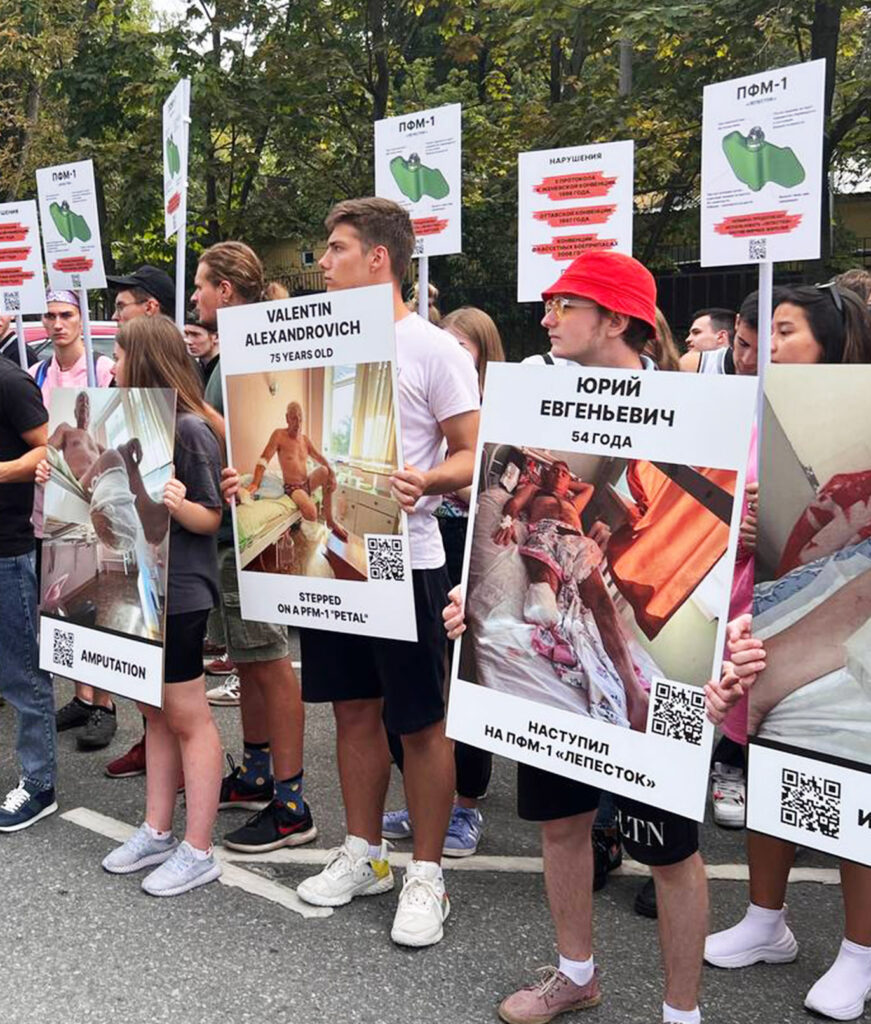
Before presenting the BBC's article and video about this incredible exercise, where Ukrainian soldiers are doing the job that they should be performing as part of a punishment for the crime they committed six months earlier, it is important to add some more context to the situation. At the time the AFU made a move in the North East, Russian forces were pre-occupied with protecting the Zaporyzhe Nuclear power plant from Ukrainian incursions and shelling, as well as trying to prevent the forced evacuation of Kherson. With reported help from MI6 and other NATO special forces, Ukraine launched a surprise offensive towards Lugansk oblast, forcing a strategic retreat by Russia from Izyum. Many of the locals accompanied them, to avoid retribution and torture as "Russian collaborators" from the invading Nationalist army. As soon as the town was "liberated" by Kiev, work began to frame Russia for supposed war crimes, including a grotesque exhumation of hundreds of bodies from a wood near the town. Those buried were mostly civilians killed by either side when Russian forces took over the town, as well as those killed by Ukrainian shelling since. While they may have lacked coffins, all the graves were identified, at least by a number, with the inventory of burials available at the local mortuary. In some cases where local people had fled East or North to Russia, they had no say in the exhumation and examination of their dead relatives. Human Rights Watch and other International bodies were closely involved in this fraud, and the claims that Russia was responsible for burying soldiers in "mass graves" in Izyum rapidly assumed a prominent status in Western media, aided by a visit from Mr Zelensky. Fittingly, as indicated in this photo, one of his guards wore a Totenkopf skull symbol on his backpack.
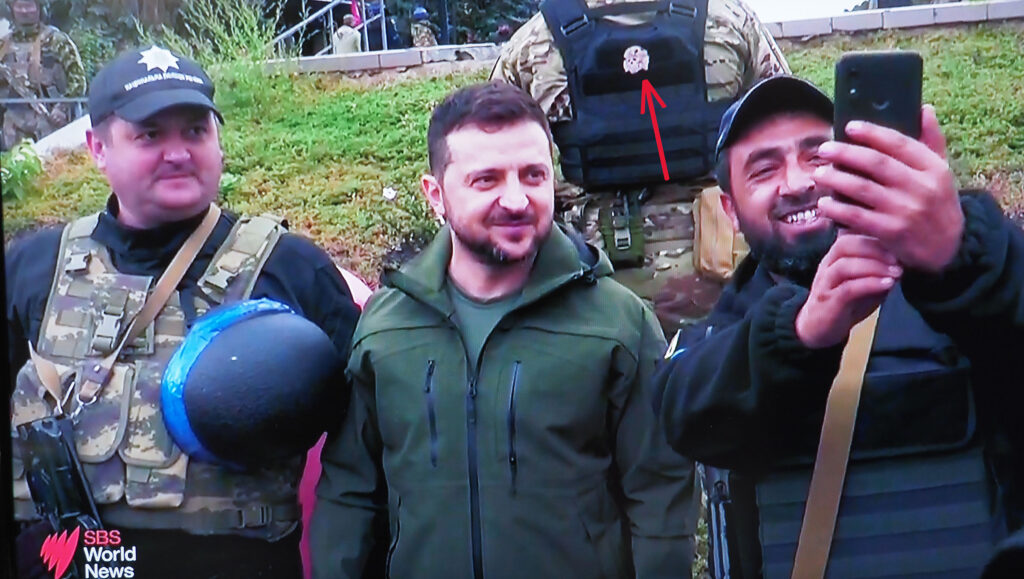
Below is James Waterhouse’s article, with this leading illustration, and quote falsely attributing the mines to Russia. The Russian army may have laid some mines on roads West of Izyum, but scattering APM clusters would have served no purpose whatsoever. If Russia subsequently manages to retake this territory, they will surely thank the AFU for removing their butterfly mines. The AFU in its turn may think better of showering territory it intends to capture with its “little rippers”.
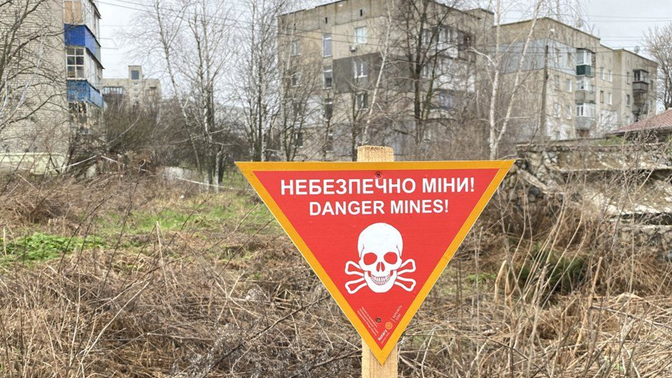
By James Waterhouse BBC Ukraine correspondent Across Ukraine's vast expanse, there are thought to be 174,000 square kilometres which are contaminated by landmines. It is an area of land larger than England, Wales and Northern Ireland combined. In the war-scarred Kharkiv region, warning signs occasionally appear next to brown, barren fields which were once front lines. Even more infrequent is the sight of demining teams sweeping their metal detectors across small, taped-off areas. A literal scratching of the surface. More landmines have been found in the Kharkiv region than anywhere else in Ukraine. This part of north-eastern Ukraine close to the Russian border has been both occupied and liberated over the past year. On 24 February 2022, Russia launched its full scale invasion and seized swathes of territory in the Kharkiv region, while also trying to capture Kharkiv city itself. By May they would lose the battle for Ukraine's second biggest city. By September, they'd be blindsided by a Ukrainian counteroffensive. The Russians deployed landmines to both defend their positions and slow the Ukrainians. After leaving in a rush, a lethal footprint was left behind. In the small town of Balakliya, on a patch of land next to an apartment block, Oleksandr Remenets' team have already found six anti-personnel mines. They'd earlier uncovered around 200 nearby. More than 55,000 explosives have been found in the area. De-miners like Oleksandr are called "heroes" by the regional authorities, yet there's a deep frustration with their efforts being dwarfed by the scale of the problem. Their desired catch are so-called butterfly mines, the most common in the area. They're only three to four inches wide, propeller shaped, and are scattered from a rocket. They're banned by international law because of the indiscriminate way they can injure and kill civilians. That hasn't stopped them from being used in this war.
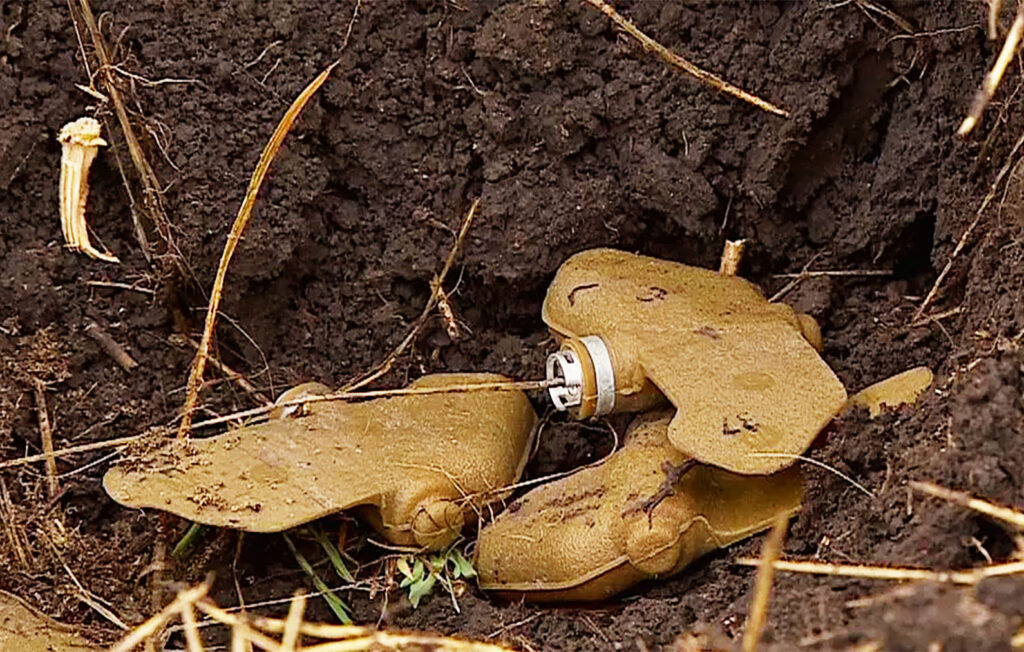
Serhiy is under the care of Yuriy Kuznetsov, an experienced trauma surgeon. A big, framed man with a tired, yet purposeful expression. He kept working throughout Russia’s occupation last year, and was the only doctor left in the Izyum hospital. He says he treats landmine casualties every week.
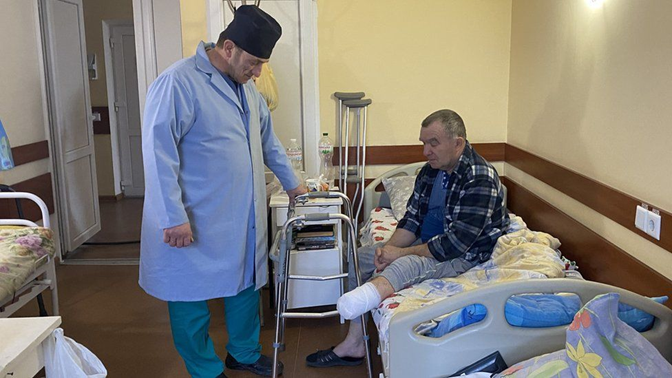
(Note that numbers of Dr Kuznetsov's patients would have been victims of Kiev's Petal mines while Izyum was under Russian control. But the long suffering and dedicated surgeon would not risk admitting this, even privately. Just being reported looking at Russian media on your phone leads to dreadful retribution from Ukrainian forces, police and civilians.) Ukraine says 724 people have been blown up by Russian mines since the invasion began last year. Izyum and its surrounding area is one of the most heavily mined places, yet the picture in the city is murky. Human Rights Watch has accused Ukraine of using illegal antipersonnel mines here. Kyiv responded by saying it followed international law while defending itself. The organisation has previously accused Russia of using similar devices across Ukraine during its full-scale invasion. (the bias towards Ukraine in this description is more evident in the video report, where Ukraine's mendacious denials are accepted and so Russia is accused by default. The final appeal for the world to help clean up the mess left by Ukraine's delinquent use of banned cluster munitions really sums it up!) According to the World Bank - which provides low interest loans to countries who need cash - de-mining Ukraine is going to cost $37.4bn (£30bn). Kyiv is trying to convince as many countries as possible to help so, in its words, "it doesn't take decades". Given how it's spent the last 70 years clearing mines from World War Two, it's an approach which will require optimism. Additional reporting by Hanna Chornous and Siobhan Leahy.
The BBC are ill-advised to draw attention to this de-mining by the AFU, given the obvious criminality of those who fired cluster mine rockets into ‘enemy’ territory. Recent claims that 40% of agricultural land in Ukraine is contaminated by land-mines, and the massive quote for the clean-up above, suggest an intention to use this issue as yet another implement to hit Russia, while disguising the identity of those responsible.
DM 15th April 2023
